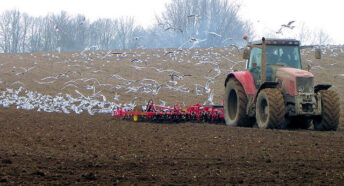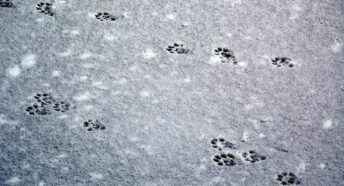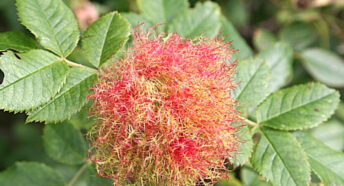What is a hedge?
I have two tall boundary hedges in my garden, one of beech, the other yew. Although a few intrepid plants clamber their way through or along them; holly, ivy and next door’s clematis, they are pretty uniform.
There are some holes where robins, sparrows and blackbirds emerge. They poke their heads out and look from side to side before descending to pick up a titbit then dashing back. I believe hedgehogs use it as a corridor and the squirrel, which steals from my bird feeders, certainly uses it as an escape route.
These cultivated hedgerows are of limited use in the general scheme of wildlife habitat.
But what is a hedgerow?
The definition used by the steering group for the UK Biodiversity Action Plan for Hedgerows is:
“A hedgerow is defined as any boundary line of trees or shrubs over 20m long and less than 5m wide at the base, provided that at one time the trees or shrubs were more or less continuous.”
On this basis, although my boundary hedges do not count, the line of shrubs and trees across the main road from where I live can legitimately be called a hedgerow. I have walked along beside it most days with my dog, so I have become very familiar with it and found interesting wildlife present since I moved here a little over a year ago.
I have not carried out a detailed survey of this local hedge. Most research on Norfolk hedges was carried out by Prof. Tom Williamson of UEA and Gerry Barnes in their survey of Norfolk hedges in “Hedgerow History: Ecology, History and Landscape Character”. They found that more than 50% of hedges contained ash, hawthorn, blackthorn, elder, elm, roses and oak. My local hedge contains all these trees plus sycamore, hornbeam, mahonia, crab apple and hazel which are less common.
Elms in the hedgerow
Elm survives here, never reaching higher than the ten metres or so, which is the limit of most elms now.
I realised they must be elms when one was blown across the footpath in one of the winter’s fierce storms. There on the tree trunk on the track, was a perfect example of the decorative tracery of Dutch Elm Disease. It resembles a multi legged spider. The disease is caused by a fungus carried by the Elm Bark Beetle which blocks the channels, the xylem, carrying food and water through the tree. It creates the distinctive tattoo which lay exposed on the smooth grey trunk, beneath the peeling rough bark.
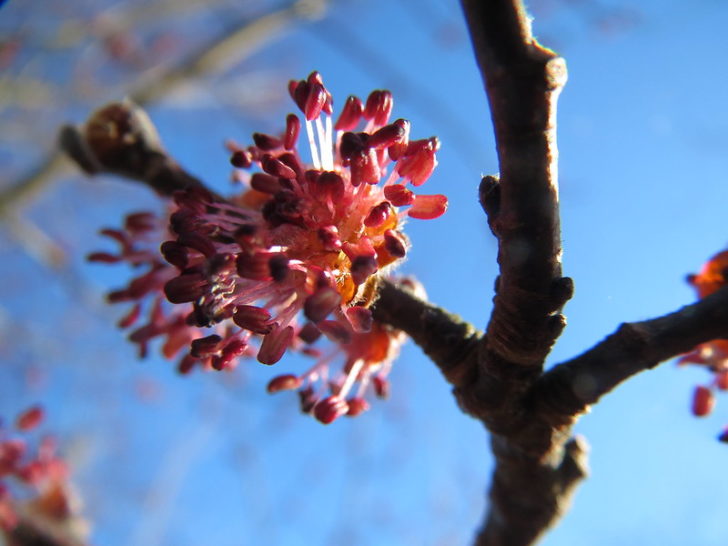
This year I noticed small trees bearing red tasselled flowers. It was early February, and the stems of the cherry plums were already covered in their white star blooms. I had thought these other trees were elms, but the red flowers puzzled me. I had never noticed such a profusion of red tree flowers before.
In late March the elm trees were covered in what I had previously imagined were the flowers, but on closer inspection were clusters of seeds in papery pale green pockets no bigger than a centimetre. Elms are hermaphrodite. The male and female parts are on the same flower. It is the feather light seed carriers that have ensured some continuity for the English elm, also known as the field elm. The seeds are dispersed by the wind to start again their determined pursuit of survival. Unfortunately, the trees mainly reproduce by root stalks so the disease spreads rapidly along hedgerows. My local hedge has a stretch of elms about twenty metres long.
Flourishing flowers
The elm and cherry plum flowers were followed by the star white flowers and stark spiny twigs of the blackthorn. The hawthorn was next to blossom. Despite the common name of “May”, it comes earlier now, partly as a result of climate change. In mid-April the heavy almond scent of the flowers is a sure sign that spring has arrived.
The verge extending beneath the hedge is a treasure trove for a flower lover. Vivid yellow biting stonecrop, a succulent, hugs the barer patches. A few swathes of vivid blue germander speedwell provide more welcome patches of colour in the spring. Last summer, I found bee orchids and a rare, endangered man orchid. Dartford pinks followed, then golden St John’s wort and citrus yellow creeping cinquefoil. There is black medick, bladder campion with its pale green, striped seed pods, resembling miniature barrage balloons.
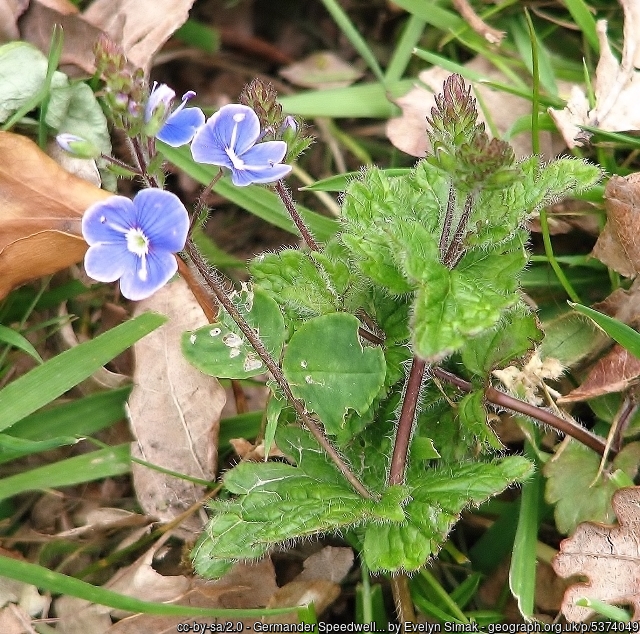
Wild carrot, common yarrow, toadflax, oregano and the purple patterned flower heads of lesser knapweed, make later appearances and old man’s beard clambers over the brambles. There are a few patches of dog’s mercury near the base of the trees, a plant often associated with old woodlands. I spot a lucerne plant, a remnant of earlier agriculture here and just one wild mignonette. Scattered statuesque candelabras of primrose, common mullein with its soft grey- green velvet leaves pop up along the verge. Here is plentiful food for butterflies and insects.
Managing and foraging
I worried that the narrow verge would be overtaken by the growth of brambles and ivy creeping out from under the trees and shrubs. Then earlier this year I heard machinery and saw that the hedges and verges were being cut. Hedgerows do have to be managed if they are not to be taken over by the vigorous varieties of bramble and ivy. The base of the hedgerow is well covered in ivy, which creeps out across the grass verge at the base, as it edges the sandy path where I walk and scrambles up the trunks of the shrubs and trees. Ivy feeds insects and birds with pollen and berries at times of year when little else is available, but it clothes many of the tree trunks and can take over any open ground.
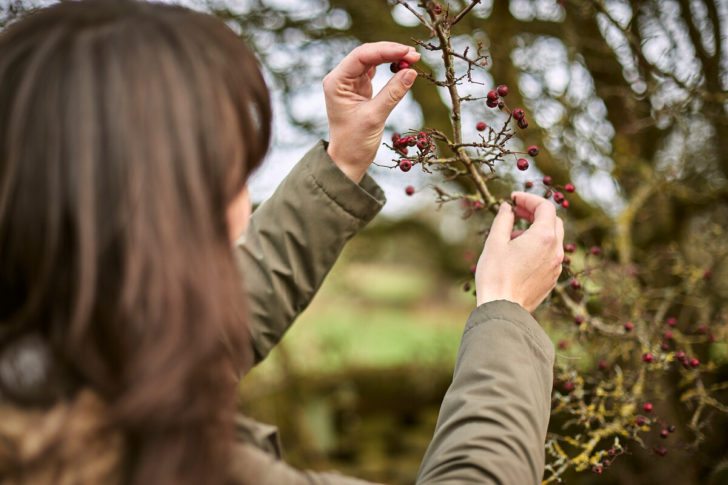
I could forage cherry plums, sloes, elderflowers and berries and blackberries. I could extend that to rose hips, hazel nuts, mahonia berries and crab apples, but I restrict myself to picking the cherry plums as they ripen, eating them as I walk. The range of food options would suggest that birds would be on the hedge in large numbers, but jays, magpies and blackbirds seem to be the most frequent visitors.
Hedgerow history
I am still working on the history of my local hedgerow. There are some clues in the plant life in the verge, some of which show the hedge was a meadow boundary, others probably demonstrate a connection with the nearby bluebell woodland.
Some hedgerow systems date back to prehistoric times, and most were well established by the Anglo-Saxon period. As permanent settlements grew and arable farming increased, living hedges provided permanent boundaries to keep stock in, although in the 12th century Richard the First issued an edict that hedges should not exceed 4 foot 6 inches tall to allow free range to the royal deer, and that he could chase them on horseback!
From the 13th Century to the start of the 17th Century, a gradual process of land enclosure and hedge planting took place, much of it associated with the increasing importance of sheep reared for wool. This often resulted in the disappearance of whole villages as large sheep ranches were created. Advances in farming practices meant new techniques could not be successfully applied in disjointed open field holdings and common land that still persisted.
In 1603 the first Act promoting enclosure was passed, to be followed by over 5,000 separate Enclosure Acts, enclosing over 7 million acres of open fields or common land. Enclosure acts specified that the plots of land they created be enclosed by hedges and ditches and subsequently maintained by the owner.
Oliver Rackham estimates that over 200,000 miles of hedge were planted between 1750 and 1850 and that this was as much as in the previous 500 years.
Prof. Tom Williamson estimates following the loss of hedges due to enclosure, and changes in keeping stock, that around 500 miles of hedgerow were grubbed out in Norfolk each year from 1946 to 1955, rising to around 2,400 miles per year by 1962, and reaching 3,500 miles over the next four years. This dropped to around 2,000 miles each year until 1970 and declined more gradually during the 1970s and 1980s.
Since 1945, the UK’s hedgerow network has shrunk by about 50%, with the annual net loss of hedgerows reaching over 11,000 miles each year in the early 1990s.
Most of the loss was due to changes in agricultural practices, but about 40,000 miles were lost due to building, quarrying, reservoirs and roads.
Just as the first World War made us recognise the importance of home-grown timber, leading to the creation of the Forestry Commission, so the second World War reminded us of the importance of home-grown food. Intensive farming methods meant larger fields with bigger machines and more industrial approaches, so hedges were removed to make this easier.
Less livestock living outdoors meant the hedges needed less management to contain them, and less people working on the land meant even more hedges were lost.
The importance of hedgerows
Like many parts of our land, we have started to understand the importance of hedgerows. They are vital to maintain the biodiversity of the country.
In Devon, a single hedge surveyed on a farm was found to benefit over 2,000 species, including many that are nationally scarce and some that are under threat. Endangered mammals, such as hazel dormice and hedgehogs, need hedges to survive.
Hedges have economic benefits too.
More coppicing could increase the amount producing biomass if we chose. Hedges help agriculture with pollination and pest control. They help control our water quality, help stopping flooding and improve air quality, especially in urban areas. Hedges are better than trees at filtering air pollution, they are a thicker barrier.
Hedgerows have a really important part to play in slowing Climate Change.
Research by CPRE suggests a 40% increase in the UK’s hedgerows would have a sequestration potential of 1.9 million tonnes of carbon. This is the equivalent of up to 7.1 million tonnes of CO2. If we incorporate an average for below ground, soil carbon storage of hedgerows into this figure, the total rises to as much as 5 million tonnes of carbon – potentially the equivalent of 18.5 million tonnes of CO2.
Despite the losses, across Britain, the Countryside Survey recorded almost 300,000 miles of ‘managed’ hedgerow still existing; enough to stretch round the earth 16 times. These are the hedgerows we see around much of the countryside. They are often managed by farmers, land owners and other land managers, such as in country parks.
The #40by50 campaign
In September last year, CPRE launched its report on hedgerows and its #40by50 campaign as proposed by the Climate Change Committee.
40 = We want to see the extent of the hedgerow network increase by 40%. This number was recommended by the independent Climate Change Committee. This means we need to create at least 120,000 miles of new and restored hedges to achieve a 40% increase in their extent – which is around half the length of our national road network.
50 = This is the time frame. We need a 40% increase by 2050 at the latest. This requires adding over 4,000 miles of new and restored hedgerows each year. Even this would only take us back to the number of hedgerows we had in the 1980’s.
Expanding our hedgerow network would be one natural solution to the climate and nature crises by increasing the nation’s capacity to absorb carbon emissions, reducing air pollution and helping reduce flood risk from extreme weather.
What we are doing
- There are trees and shrubs available for planting, but we need places, and people, to plant them, and then to make sure they are cared for and maintained.
- Farmers and landowners are working hard, supported by Environmental Land Management payments. Nationally, CPRE have worked with Farmers Weekly on a new survey asking farmers how they manage the hedgerows on their land, and what more support they would like.
- CPRE Norfolk have written to all Norfolk MPs to ask them to become Hedgerow Heroes.
What we want our councils to do
- Planning Authorities need to develop policies in local plans to ensure that hedgerow planting is integrated in new developments and that any damage to existing hedgerows is avoided (biodiversity net gain should never justify the removal of important hedgerows).
- Local people and Parish Councils have a huge part to play. We would like each Parish to have its own Hedgerow Hero too.
- Parishes could work with local community groups to plant hedgerows in urban, and urban fringe areas, enhancing green infrastructure and directing funding to help deliver Local Nature Recovery Strategies.
We need you to help too
- Sign our hedgerow petition now!
- Read the CPRE national report – Hedge fund: investing in hedgerows for climate, nature and the economy
- Appreciate and learn about the hedgerows near you with CPRE’s handy booklet ‘A little rough guide around the hedges’.





